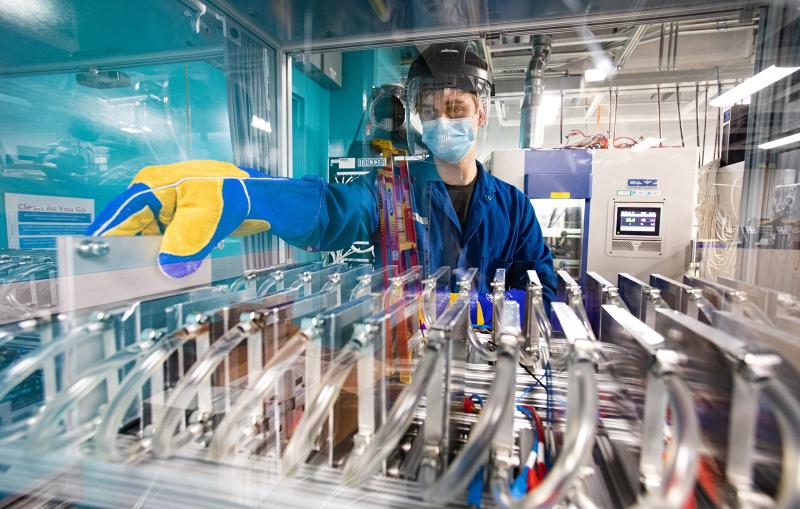A new hands-off probe uses light to explore the subtleties of electron behavior in a topological insulator
Just as pressing a guitar string produces a higher pitch, sending laser light through a material can shift it to higher energies and higher frequencies. Now scientists have discovered how to use this phenomenon to explore quantum materials in a new and much more detailed way.
By Glennda Chui
Topological insulators are one of the most puzzling quantum materials – a class of materials whose electrons cooperate in surprising ways to produce unexpected properties. The edges of a TI are electron superhighways where electrons flow with no loss, ignoring any impurities or other obstacles in their path, while the bulk of the material blocks electron flow.
Scientists have studied these puzzling materials since their discovery just over a decade ago with an eye to harnessing them for things like quantum computing and information processing.
Now researchers at the Department of Energy’s SLAC National Accelerator Laboratory and Stanford University have invented a new, hands-off way to probe the fastest and most ephemeral phenomena within a TI and clearly distinguish what its electrons are doing on the superhighway edges from what they’re doing everywhere else.
The technique takes advantage of a phenomenon called high harmonic generation, or HHG, which shifts laser light to higher energies and higher frequencies – much like pressing a guitar string produces a higher note – by shining it through a material. By varying the polarization of laser light going into a TI and analyzing the shifted light coming out, researchers got strong and separate signals that told them what was happening in each of the material’s two contrasting domains.
“What we found out is that the light coming out gives us information about the properties of the superhighway surfaces,” said Shambhu Ghimire, a principal investigator with the Stanford PULSE Institute at SLAC, where the work was carried out. “This signal is quite remarkable, and its dependence on the polarization of the laser light is dramatically different from what we see in conventional materials. We think we have a potentially novel approach for initiating and probing quantum behaviors that are supposed to be present in a broad range of quantum materials.”
The research team reported the results today in Physical Review A.
Light in, light out
Starting in 2010, a series of experiments led by Ghimire and PULSE Director David Reis showed HHG can be produced in ways that were previously thought unlikely or even impossible: by beaming laser light into a crystal, a frozen argon gas or an atomically thin semiconductor material. Another study described how to use HHG to generate attosecond laser pulses, which can be used to observe and control the movements of electrons, by shining a laser through ordinary glass.
In 2018, Denitsa Baykusheva, a Swiss National Science Foundation Fellow with a background in HHG research, joined the PULSE group as a postdoctoral researcher. Her goal was to study the potential for generating HHG in topological insulators – the first such study in a quantum material. “We wanted to see what happens to the intense laser pulse used to generate HHG,” she said. “No one had actually focused such a strong laser light on these materials before.”
But midway through those experiments, the COVID-19 pandemic hit and the lab shut down in March 2020 for all but essential research. So the team had to think of other ways to make progress, Baykusheva said.
“In a new area of research like this one, theory and experiment have to go hand in hand,” she explained. “Theory is essential for explaining experimental results and also predicting the most promising avenues for future experiments. So we all turned ourselves into theorists” – first working with pen and paper and then writing code and doing calculations to feed into computer models.
An illuminating result
To their surprise, the results predicted that circularly polarized laser light, whose waves spiral around the beam like a corkscrew, could be used to trigger HHG in topological insulators.

“One of the interesting things we observed is that circularly polarized laser light is very efficient at generating harmonics from the superhighway surfaces of the topological insulator, but not from the rest of it,” Baykusheva said. “This is something very unique and specific to this type of material. It can be used to get information about electrons that travel the superhighways and those that don't, and it can also be used to explore other types of materials that can’t be probed with linearly polarized light.”
The results lay out a recipe for continuing to explore HHG in quantum materials, said Reis, who is a co-author of the study.
“It’s remarkable that a technique that generates strong and potentially disruptive fields, which takes electrons in the material and jostles them around and uses them to probe the properties of the material itself, can give you such a clear and robust signal about the material’s topological states,” he said.
“The fact that we can see anything at all is amazing, not to mention the fact that we could potentially use that same light to change the material’s topological properties.”
Experiments at SLAC have resumed on a limited basis, Reis added, and the results of the theoretical work have given the team new confidence that they know exactly what they are looking for.
Researchers from the Max Planck POSTECH/KOREA Research Initiative also contributed to this report. Major funding for the study came from the DOE Office of Science and the Swiss National Science Foundation.
Citation: Denitsa Baykusheva et al., Physical Review A, 2 February 2020 (10.1103/PhysRevA.103.023101)
For questions or comments, contact the SLAC Office of Communications at communications@slac.stanford.edu.
SLAC is a vibrant multiprogram laboratory that explores how the universe works at the biggest, smallest and fastest scales and invents powerful tools used by scientists around the globe. With research spanning particle physics, astrophysics and cosmology, materials, chemistry, bio- and energy sciences and scientific computing, we help solve real-world problems and advance the interests of the nation.
SLAC is operated by Stanford University for the U.S. Department of Energy’s Office of Science. The Office of Science is the single largest supporter of basic research in the physical sciences in the United States and is working to address some of the most pressing challenges of our time.






